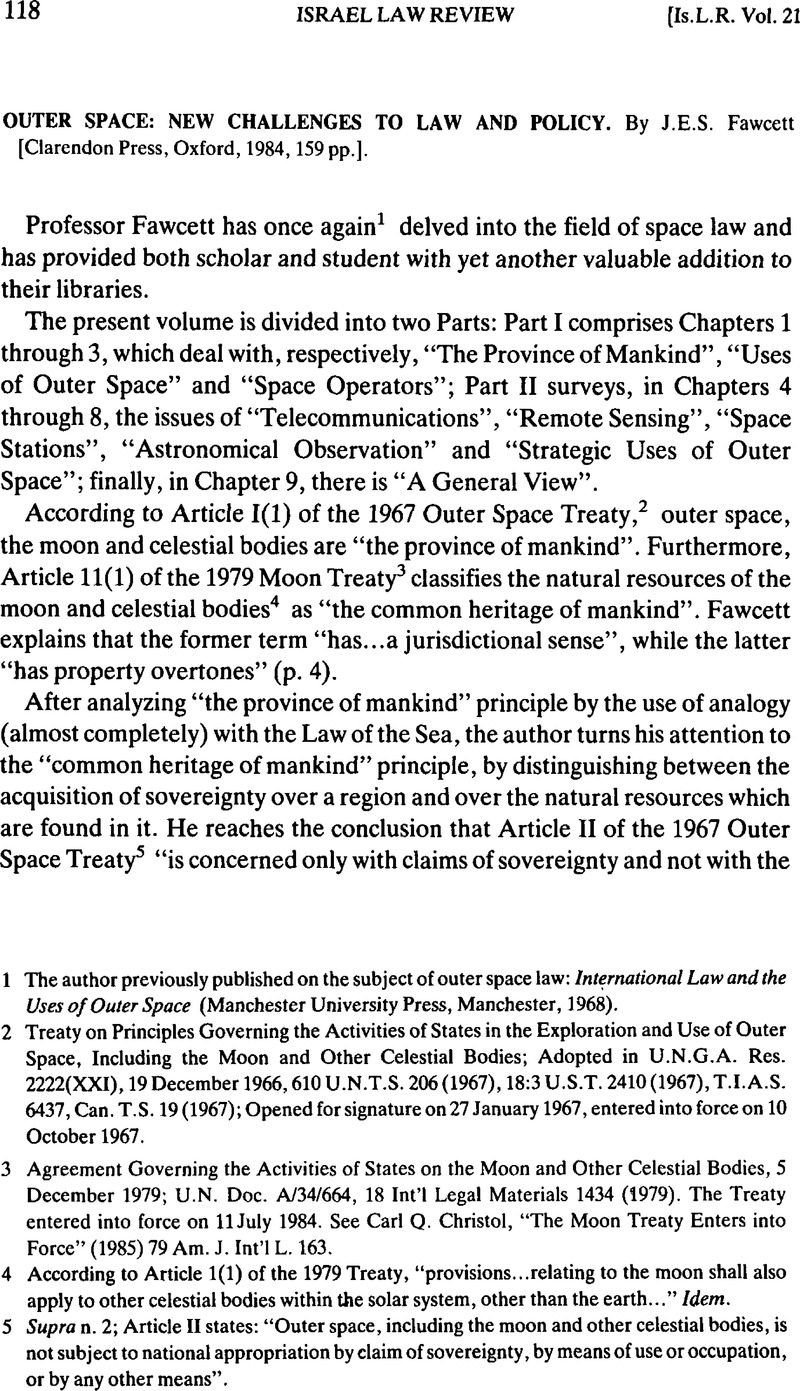No CrossRef data available.
Article contents
Outer Space: New Challenges to Law and Policy. By J.E.S. Fawcett [Clarendon Press, Oxford, 1984, 159 pp.].
Published online by Cambridge University Press: 16 February 2016
Abstract

- Type
- Books
- Information
- Copyright
- Copyright © Cambridge University Press and The Faculty of Law, The Hebrew University of Jerusalem 1986
References
1 The author previously published on the subject of outer space law: International Law and the Uses of Outer Space (Manchester University Press, Manchester, 1968)Google Scholar.
2 Treaty on Principles Governing the Activities of States in the Exploration and Use of Outer Space, Including the Moon and Other Celestial Bodies; Adopted in U.N.G.A. Res. 2222(XXI), 19 December 1966,610 U.N.T.S. 206 (1967), 18:3 U.S.T. 2410 (1967), T.I.A.S. 6437, Can. T.S. 19 (1967); Opened for signature on 27 January 1967, entered into force on 10 October 1967.
3 Agreement Governing the Activities of States on the Moon and Other Celestial Bodies, 5 December 1979; U.N. Doc. A/34/664, 18 Int'l Legal Materials 1434 (1979). The Treaty entered into force on 11 July 1984. See Christol, Carl Q., “The Moon Treaty Enters into Force” (1985) 79 Am. J. Int'l L. 163CrossRefGoogle Scholar.
4 According to Article 1(1) of the 1979 Treaty, “provisions…relating to the moon shall also apply to other celestial bodies within the solar system, other than the earth…” Idem.
5 Supra n. 2; Article II states: “Outer space, including the moon and other celestial bodies, is not subject to national appropriation by claim of sovereignty, by means of use or occupation, or by any other means”.
6 Supra n 3, Article 11 states, in part “1 The moon and its natural resources are the common heritage of mankind, which finds its expression in the provisions of this Agreement 2. The moon is not subject to national appropriation by any claim of sovereignty, by means of use or occupation, or by any other means”.
7 Id., Article 6(2) states “In carrying out scientific investigations and in furtherance of the provisions of this Agreement, the States Parties shall have the right to collect on and remove from the moon samples of its minerals and other substances. Such samples shall remain at the disposal of those States Parties which caused them to be collected and may be used by them for scientific purposes. States Parties shall have regard to the desirabilty of making a portion of such samples available to other interested States Parties and the international scientific community for scientific investigation. States Parties may in the course of scientific investigations also use mineral and other substances of the moon in quantities appropriate for the support of their missions”.
8 Id., Article 12(1) states “States Parties shall retain jurisdiction and control over their personnel, space vehicles, equipment, facilities, stations and installations on the moon. The ownership of space vehicles, equipment, facilities, stations and installations shall not be affected by their presence on the moon”.
9 Supra n. 2; Article I(1).
10 Idem.
11 Id.; Articles I(2) and III.
12 Id.; Article III.
13 Id.; Article IV(2).
14 Id.; Article IX.
15 Agreement on the Rescue of Astronauts, the Return of Astronauts and the Return of Objects Launched Into Outer Space; Adopted in U.N.G.A. Res. 2345(XXII), 19 December 1967, 672 U.N.T.S. 120 (1969), 19 U.S.T. 7570 (1967), T.I.A.S. 6599; Opened for signature on 22 April 1968, entered into force on 3 December 1968; Article 6.
16 Convention on International Liability for Damage Caused by Space Objects; Adopted in U.N.G.A. Res. 2777(XXVI), 29 November 1971, 24:3 U.S.T. 2389 (1973), T.I.A.S. 7762; Opened for signature on 29 March 1972, entered into force on 9 October 1973; Article XXII.
17 Convention on Registration of Objects Launched Into Outer Space; Adopted in U.N.G.A. Res. 3232(XXIV), 12 November 1974, 28:1 U.S.T. 695 (1976–77), T.I.A.S. 8480, Can. T.S. 36 (1976); Opened for signature on 14 January 1975, entered into force on 15 September 1976; Article VII.
18 Supra n. 3; Article 16.
19 The European Space Agency has announced its acceptance of the obligations and right of, and has thus become a “Party” to, the 1968 Rescue and Return Agreement and the 1975 Registration Convention. Christol, Carl Q., The Modern International Law of Outer Space (New York, 1982) 912Google Scholar.
20 UN Doc. A/RES/37/92 (4 February 1983); reprinted in (1983) 77 Am. J. Int'l L. 733CrossRefGoogle Scholar.
21 See, for example, Cheng, Bin, “United Nations Resolutions on Outer Space: ‘Instant’ International Customary Law?” (1965) 5 In. J. Int'l L. 38Google Scholar.
22 UN Doc. A/AC.105/118 (12 June 1973).
23 Lachs, Manfred, The Law of Outer Space (Leiden, 1972) 60Google Scholar
24 Texts of Draft Principles as Contained in the Report of the Legal Sub-Committee on the Work of its Twentieth Session (A/AC.105/288, Annex I, Appendix), With Changes Made at Present Session, UN Doc. A/AC.105/320, pp. 16-36 (1983); reprinted in (1983) 11 J. Space L.
25 For an excellent study of this issue see Smith, Delbert D., Space Stations: International Law and Policy (1979)Google Scholar.




